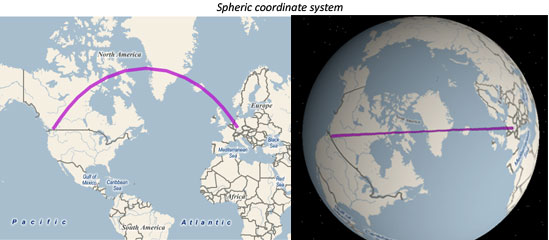Pseudoscientific flat Earth hypotheses originated with the English writer Samuel Rowbotham (1816–1884). Based on his conclusions derived from the Bedford Level experiment (https://en.wikipedia.org/wiki/Bedford_Level_experiment), Rowbotham published a 16-page pamphlet, Zetetic Astronomy, which he later expanded into a 430-page book, Earth Not a Globe, in which the Earth is a flat disc centred at the North Pole and bounded along its southern edge by a wall of ice (Antarctica), with the Sun and Moon 3,000 miles (4,800 km) and the "cosmos" 3,100 miles (5,000 km) above Earth.[1] He also published a leaflet entitled "The inconsistency of Modern Astronomy and its Opposition to the Scriptures!!", which argued that the "Bible, alongside our senses, supported the idea that the earth was flat and immovable and this essential truth should not be set aside for a system based solely on human conjecture".[2]
Rowbotham and followers like William Carpenter, who continued the belief, gained attention by successful use of pseudoscience in public debates with leading scientists of the day. One such debate, involving Alfred Russel Wallace, concerned the Bedford Level experiment (and later led to several lawsuits for fraud and libel).[3][4][5] Rowbotham created a Zetetic Society in England and New York, shipping over a thousand copies of Zetetic Astronomy.[6]
After Rowbotham's death, Lady Elizabeth Blount, wife of explorer Sir Walter de Sodington Blount, established a Universal Zetetic Society, whose objective was "the propagation of knowledge related to Natural Cosmogony in confirmation of the Holy Scriptures, based on practical scientific investigation". The society published a magazine, The Earth Not a Globe Review, and remained active well into the early 20th century.[7] A flat Earth journal, Earth: a Monthly Magazine of Sense and Science, was published between 1901–1904, edited by Lady Blount.[8]
The International Flat Earth Research Society (IFERS), the first modern Flat Earth society organization, was founded by Englishman Samuel Shenton in 1956[9] and was later led by American Charles K. Johnson, who based the organization in his home town of Lancaster, California. The belief lacked representation after Johnson’s death in 2001, until the name was reclaimed in 2004 by Johnson's self-proclaimed successor 'Daniel Shenton' (likely a reference to Samuel Shenton), a man claiming to live in Hong Kong.
In 1956, Samuel Shenton, a signwriter by trade, created the International Flat Earth Society as a successor to the Universal Zetetic Society and ran it as "organizing secretary" from his home in Dover, England.[7][14] Given Shenton's interest in alternative science and technology, the emphasis on religious arguments was less than in the predecessor society.[15]
When satellite images showed Earth as a sphere, Shenton remarked: "It's easy to see how a photograph like that could fool the untrained eye".[16]
It was not until the advent of human spaceflight that Shenton attracted wide publicity, being featured in The New York Times in January and June 1964, when the epithet "flat-earther" was also slung across the floor of the House of Commons of the United Kingdom in both directions.
The society also claimed that the Apollo Moon landings were a hoax staged by Hollywood (a position also held outside the Flat Earth Society).
In 1969, Shenton persuaded Ellis Hillman, a Polytechnic lecturer, to become president of the Flat Earth Society; but there is little evidence of any activity on his part until after Shenton's death, when he added most of Shenton's library to the archives of the Science Fiction Foundation he helped to establish.
Shenton died in 1971; Charles K. Johnson, inheriting part of Shenton's library from Shenton's wife, established and became president of the International Flat Earth Research Society of America and Covenant People's Church in California. Under his leadership, over the next three decades, the Flat Earth Society grew from a few members to a reported 3,500.[19] Johnson gave newsletters, flyers, maps, and other publications to anyone who asked for them, and managed all membership applications together with his wife, Marjory. The most famous of these newsletters was Flat Earth News. Johnson paid for these publications through annual member dues costing US$6 to US$10 over the course of his leadership.[20] Johnson's beliefs were based on the Bible, and he saw scientists as pulling a hoax which would replace religion with science.
The Flat Earth Society's most recent world model is that humanity lives on a disc, with the North Pole at its center and a 150-foot (45 m) high wall of ice (Antarctica) at the outer edge.[21] The resulting map resembles the symbol of the United Nations, which Johnson used as evidence for his position.[22] In this model, the Sun and Moon are each 32 miles (52 km) in diameter.[23]
Flat Earth Society recruited members by speaking against the U. S. government and all its agencies, particularly NASA. Much of the society’s literature in its early days focused on interpreting the Bible to mean that the Earth is flat, although they did try to offer scientific explanations and evidence.[20]
Flat Earth News
Flat Earth News, was a quarterly, four-page tabloid.[20]
Some headlines from Flat Earth News during the 1970s and early 1980s:[24]
"Whole World Deceived... Except the Very Elect" (Dec. 1977)
"Australia Not Down Under" (May 1978)
"Sun Is a Light 32 Miles Across" (Dec. 1978)
"The Earth Has No Motion" (Jun. 1979)
"Nikita Krushchev Father of NASA" (Mar. 1980)
"Galileo Was a Liar" (Dec. 1980)
"Science Insults Your Intelligence" (Sep. 1980)
"World IS Flat, and That's That" (Sep. 1980)
"The Earth Is Not a Ball; Gravity Does Not Exist" (Mar. 1981)
Peak and decline
The group rose to 3,500 members under Charles K. Johnson.[19] Later, "Flat-earther" became a common epithet for someone who stubbornly adheres to discredited or outmoded ideas.
The society fell to 200 members by 1980. Eugenie Scott called them an example of "extreme Biblical-literalist theology: The earth is flat because the Bible says it is flat, regardless of what science tells us".[25] The society was further affected by a fire at the house of Charles K. Johnson which destroyed all of the records and contacts of members of the Society. Johnson’s wife, who helped manage the database, died shortly thereafter. Johnson himself died on March 19, 2001.
Modern Flat Earth Societies
In 2004, Daniel Shenton (not related to Samuel[27]) resurrected the Flat Earth Society, basing it around a web-based discussion forum.[28] This eventually led to the official relaunch of the society in October 2009,[29] and the creation of a new website, featuring the world's largest public collection of Flat Earth literature and a user-edited encyclopedia.[30] Moreover, the society began accepting new members for the first time since 2001, with musician Thomas Dolby becoming the first member to join the newly reconvened society. As of July 2014, over 500 people have become members.[31] Shenton has also conducted several interviews since the society's relaunch, including in The Guardian newspaper.[12]
In 2013, part of this society broke away to form a new web-based group also featuring a forum and wiki.[32] In 2015, an independent Flat Earther Eric Dubay started an online debate forum named after the first modern Flat Earth Society, The International Flat Earth Research Society (IFERS).[33] Eric did this out of his belief that all other Flat Earth societies are "controlled opposition". [34] Eric Dubay has published videos on YouTube claiming to prove the earth is flat.
Canadian society
Flat Earth Society of Canada was established on 8 November 1970 by philosopher Leo Ferrari, writer Raymond Fraser and poet Alden Nowlan;[35] and was active until 1984.[36] Calling themselves planoterrestrialists,[37] their aims were quite different from other flat earth societies. With obvious humorous overtones, they claimed a prevailing problem of the new technological age was the willingness of people to accept theories "on blind faith and to reject the evidence of their own senses."[36] They did not actually believe Flat Earth theories, considering their proponents cranks, and did not accept such people into their society, which was made of quite a few prominent members of Canadian literary and political circles.
They published a newsletter, The Official Chronicle and promoted their ideas more widely via television and press. Its main aims were "to combat the fallacious deification of the circle," "to restore man's confidence in the validity of his own perceptions", and "to spearhead man's escape from his metaphysical and geometrical prison."
As of 2003, Iris Taylor of I. Taylor Research has worked to reinstate the Canadian Chapter of the Flat Earth Society and recruit new members.






